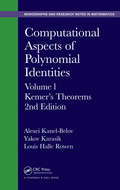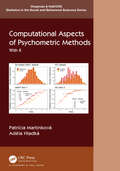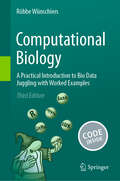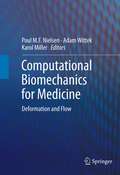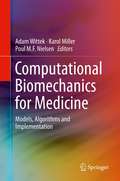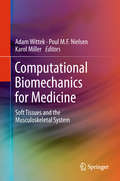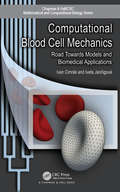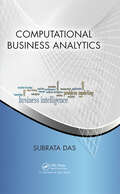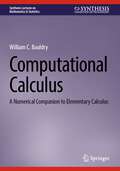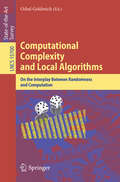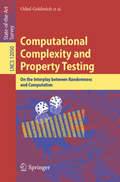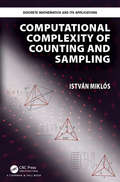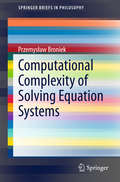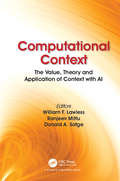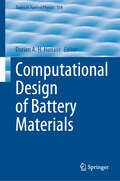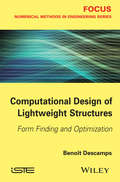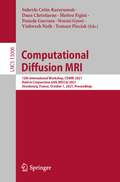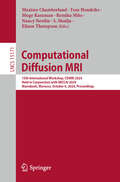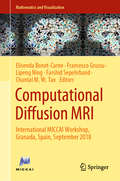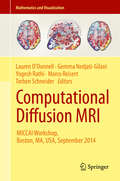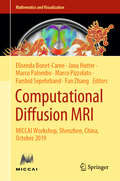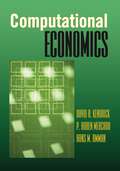- Table View
- List View
Computational Aspects of Polynomial Identities: Volume l, Kemer's Theorems, 2nd Edition
by Alexei Kanel-Belov Yakov Karasik Louis Halle RowenComputational Aspects of Polynomial Identities: Volume l, Kemer's Theorems, 2nd Edition presents the underlying ideas in recent polynomial identity (PI)-theory and demonstrates the validity of the proofs of PI-theorems. This edition gives all the details involved in Kemer's proof of Specht's conjecture for affine PI-algebras in characteristic 0.The
Computational Aspects of Psychometric Methods: With R (Chapman & Hall/CRC Statistics in the Social and Behavioral Sciences)
by Patricia Martinková Adéla HladkáThis book covers the computational aspects of psychometric methods involved in developing measurement instruments and analyzing measurement data in social sciences. It covers the main topics of psychometrics such as validity, reliability, item analysis, item response theory models, and computerized adaptive testing. The computational aspects comprise the statistical theory and models, comparison of estimation methods and algorithms, as well as an implementation with practical data examples in R and also in an interactive ShinyItemAnalysis application. Key Features: Statistical models and estimation methods involved in psychometric research Includes reproducible R code and examples with real datasets Interactive implementation in ShinyItemAnalysis application The book is targeted toward a wide range of researchers in the field of educational, psychological, and health-related measurements. It is also intended for those developing measurement instruments and for those collecting and analyzing data from behavioral measurements, who are searching for a deeper understanding of underlying models and further development of their analytical skills.
Computational Biology: A Practical Introduction to Bio Data Juggling with Worked Examples
by Röbbe WünschiersThis extensively expanded third edition offers a practical introduction to Bio Data Science. With a hands-on approach to learning, this book offers ample opportunities to practice: - Installing and utilizing Linux as a virtual machine or remotely - Processing bio data with the programming language AWK - Managing data with the relational database system MariaDB - Analyzing and visualizing data with R - Implementing good bioinformatics practices with Jupyter Notebook and GitHub This book targets both students and professionals in the life sciences. While it is aimed at beginners, it also provides valuable tips and tricks for experienced researchers dealing with large datasets. Worked examples illustrate how to utilize various bioinformatics tools such as BLAST, Clustal, PLINK, IGV, SAMtools, BCFtools, Mason2, Minimap, NCBI Datasets, Velvet, Jmol, and more for: - Identifying bacterial proteins potentially associated with pathogenicity - Querying molecular structures for redox-regulated enzymes - Mapping and assembling real or simulated sequence reads - Identifying and mapping molecular structure mutations in viruses - Conducting genome-wide association studies All software tools and datasets mentioned are freely available, and all code is accessible as Jupyter Notebooks on GitHub. Drawing from the author's experiences and knowledge gained from both academia and industry, this book provides a practical and comprehensive approach to bioinformatics.
Computational Biomechanics for Medicine: Deformation and Flow
by Poul M.F. Nielsen Karol Miller Adam WittekOne of the greatest challenges for mechanical engineers is to extend the success of computational mechanics to fields outside traditional engineering, in particular to biology, biomedical sciences, and medicine. This book is an opportunity for computational biomechanics specialists to present and exchange opinions on the opportunities of applying their techniques to computer-integrated medicine.<P><P> Computational Biomechanics for Medicine: Deformation and Flow collects the papers from the Medical Image Computing and Computer Assisted Intervention conference (MICCAI 2011) dedicated to research in the field of medical image computing and computer assisted medical interventions. The topics covered include: medical image analysis, image-guided surgery, surgical simulation, surgical intervention planning, disease prognosis and diagnostics, injury mechanism analysis, implant and prostheses design, and medical robotics.
Computational Biomechanics for Medicine: Models, Algorithms and Implementation
by Poul M.F. Nielsen Karol Miller Adam WittekOne of the greatest challenges for mechanical engineers is to extend the success of computational mechanics to fields outside traditional engineering, in particular to biology, biomedical sciences, and medicine. This book is an opportunity for computational biomechanics specialists to present and exchange opinions on the opportunities of applying their techniques to computer-integrated medicine. Computational Biomechanics for Medicine: Models, Algorithms and Implementation collects the papers from the Seventh Computational Biomechanics for Medicine Workshop held in Nice in conjunction with the Medical Image Computing and Computer Assisted Intervention conference. The topics covered include: medical image analysis, image-guided surgery, surgical simulation, surgical intervention planning, disease prognosis and diagnostics, injury mechanism analysis, implant and prostheses design, and medical robotics.
Computational Biomechanics for Medicine: Soft Tissues and the Musculoskeletal System
by Poul M.F. Nielsen Karol Miller Adam WittekOne of the greatest challenges for mechanical engineers is to extend the success of computational mechanics to fields outside traditional engineering, in particular to biology, biomedical sciences, and medicine. The proposed workshop will provide an opportunity for computational biomechanics specialists to present and exchange opinions on the opportunities of applying their techniques to computer-integrated medicine. <P><P> Computational Biomechanics for Medicine: Soft Tissues and the Musculoskeletal System collects the papers from the Medical Image Computing and Computer Assisted Intervention conference (MICCAI 2010) in Beijing, dedicated to research in the field of medical image computing and computer assisted medical interventions. The topics covered include: medical image analysis, image-guided surgery, surgical simulation, surgical intervention planning, disease prognosis and diagnostics, injury mechanism analysis, implant and prostheses design, medical robotics.
Computational Blood Cell Mechanics: Road Towards Models and Biomedical Applications (Chapman & Hall/CRC Computational Biology Series)
by Ivan Cimrak Iveta JancigovaSimulating blood cells for biomedical applications is a challenging goal. Whether you want to investigate blood flow behavior on the cell scale, or use a blood cell model for fast computational prototyping in microfluidics, Computational Blood Cell Mechanics will help you get started, and show you the path forward. The text presents a step-by-step approach to cell model building that can be adopted when developing and validating models for biomedical applications, such as filtering and sorting cells, or examining flow and deformations of individual cells under various conditions. It starts with basic building-blocks that, together, model the red blood cell membrane according to its physical properties, before moving on to discuss several issues that may pose problems along the way, and finally leads to suggestions on how to set up computational experiments. More details available at www.compbloodcell.eu
Computational Business Analytics (Chapman & Hall/CRC Data Mining and Knowledge Discovery Series #34)
by Subrata DasThis book presents tools and techniques for descriptive, predictive, and prescriptive analytics applicable across multiple domains. The author first covers core descriptive and inferential statistics for analytics and then enhances numerical statistical techniques with symbolic artificial intelligence and machine learning techniques for richer predictive and prescriptive analytics. Through many examples and challenging case studies from a variety of fields, practitioners easily see the connections to their own problems and can then formulate their own solution strategies.
Computational Calculus: A Numerical Companion to Elementary Calculus (Synthesis Lectures on Mathematics & Statistics)
by William C. BauldryThis book offers readers the methods that are necessary to apply the power of calculus to analyze real problems. While most calculus textbooks focus on formula-based calculus, this book explains how to do the analysis of calculus, rates of change, and accumulation from data. The author’s introductory approach prepares students with the techniques to handle numerically-based problems in more advanced classes or in real-world applications. This self-contained book uses the computer algebra system Maple for computation, and the material is easily adaptable for calculators or other computer algebra systems. The author includes historical context and example exercises throughout the book in order to provide readers with a thorough understanding of the topic. This book:Prepares students with the techniques to handle numerically-based problems in in real-world applicationsProvides historical context and example exercises to give a thorough understanding of the topicUtilizes Maple for computation and is adaptable for calculators or other computer algebra systems
Computational Cancer Biology: An Interaction Network Approach (SpringerBriefs in Electrical and Computer Engineering)
by Mathukumalli VidyasagarThis brief introduces people with a basic background in probability theory to various problems in cancer biology that are amenable to analysis using methods of probability theory and statistics. The title mentions "cancer biology" and the specific illustrative applications reference cancer data but the methods themselves are more broadly applicable to all aspects of computational biology. Aside from providing a self-contained introduction to basic biology and to cancer, the brief describes four specific problems in cancer biology that are amenable to the application of probability-based methods. The application of these methods is illustrated by applying each of them to actual data from the biology literature. After reading the brief, engineers and mathematicians should be able to collaborate fruitfully with their biologist colleagues on a wide variety of problems.
Computational Complexity and Local Algorithms: On the Interplay Between Randomness and Computation (Lecture Notes in Computer Science #15700)
by Oded GoldreichThis volume contains a collection of studies in the areas of complexity theory and local algorithms. A common theme in most of the papers is the interplay between randomness and computation. This interplay is pivotal to some parts of complexity theory and is essential for local algorithms. The works included address a variety of topics in the areas of complexity theory and local algorithms. Within complexity theory the topics include approximation algorithms, counting problems, enumeration problems, explicit construction of expander graphs, fine grained complexity, interactive proof systems, PPT-search and pseudodeterminism, space complexity, and worst-case to average-case reductions. Within local algorithms the focus is mostly on property testing and on locally testable and decodable codes. In particular, many of the works seek to advance the study of testing graph properties in the bounded-degree graph model. Other topics in property testing include testing group properties and testing properties of affine subspaces.
Computational Complexity and Property Testing: On the Interplay Between Randomness and Computation (Lecture Notes in Computer Science #12050)
by Itai Benjamini Avi Wigderson Scott Decatur Maya Leshkowitz Or Meir Dana Ron Guy Rothblum Avishay Tal Liav Teichner Roei TellThis volume contains a collection of studies in the areas of complexity theory and property testing. The 21 pieces of scientific work included were conducted at different times, mostly during the last decade. Although most of these works have been cited in the literature, none of them was formally published before. Within complexity theory the topics include constant-depth Boolean circuits, explicit construction of expander graphs, interactive proof systems, monotone formulae for majority, probabilistically checkable proofs (PCPs), pseudorandomness, worst-case to average-case reductions, and zero-knowledge proofs.Within property testing the topics include distribution testing, linearity testing, lower bounds on the query complexity (of property testing), testing graph properties, and tolerant testing. A common theme in this collection is the interplay between randomness and computation.
Computational Complexity of Counting and Sampling (Discrete Mathematics and Its Applications)
by Istvan MiklosComputational Complexity of Counting and Sampling provides readers with comprehensive and detailed coverage of the subject of computational complexity. It is primarily geared toward researchers in enumerative combinatorics, discrete mathematics, and theoretical computer science. The book covers the following topics: Counting and sampling problems that are solvable in polynomial running time, including holographic algorithms; #P-complete counting problems; and approximation algorithms for counting and sampling. First, it opens with the basics, such as the theoretical computer science background and dynamic programming algorithms. Later, the book expands its scope to focus on advanced topics, like stochastic approximations of counting discrete mathematical objects and holographic algorithms. After finishing the book, readers will agree that the subject is well covered, as the book starts with the basics and gradually explores the more complex aspects of the topic. Features: Each chapter includes exercises and solutions Ideally written for researchers and scientists Covers all aspects of the topic, beginning with a solid introduction, before shifting to computational complexity’s more advanced features, with a focus on counting and sampling
Computational Complexity of Solving Equation Systems (SpringerBriefs in Philosophy)
by Przemysław BroniekThis volume considers the computational complexity of determining whether a system of equations over a fixed algebra A has a solution. It examines in detail the two problems this leads to: SysTermSat(A) and SysPolSat(A), in which equations are built out of terms or polynomials, respectively. The book characterizes those algebras for which SysPolSat can be solved in a polynomial time. So far, studies and their outcomes have not covered algebras that generate a variety admitting type 1 in the sense of Tame Congruence Theory. Since unary algebras admit only type 1, this book focuses on these algebras to tackle the main problem. It discusses several aspects of unary algebras and proves that the Constraint Satisfaction Problem for relational structures is polynomially equivalent to SysTermSat over unary algebras. The book's final chapters discuss partial characterizations, present conclusions, and describe the problems that are still open.
Computational Context: The Value, Theory and Application of Context with AI
by Ranjeev Mittu Donald Sofge William F. LawlessThis volume addresses context from three comprehensive perspectives: first, its importance, the issues surrounding context, and its value in the laboratory and the field; second, the theory guiding the AI used to model its context; and third, its applications in the field (e.g., decision-making). This breadth poses a challenge. The book analyzes how the environment (context) influences human perception, cognition and action. While current books approach context narrowly, the major contribution of this book is to provide an in-depth review over a broad range of topics for a computational context no matter its breadth. The volume outlines numerous strategies and techniques from world-class scientists who have adapted their research to solve different problems with AI, in difficult environments and complex domains to address the many computational challenges posed by context. Context can be clear, uncertain or an illusion. Clear contexts: A father praising his child; a trip to the post office to buy stamps; a policewoman asking for identification. Uncertain contexts: A sneak attack; a surprise witness in a courtroom; a shout of "Fire! Fire!" Contexts as illusion: Humans fall prey to illusions that machines do not (Adelson’s checkerboard illusion versus a photometer). Determining context is not easy when disagreement exists, interpretations vary, or uncertainty reigns. Physicists like Einstein (relativity), Bekenstein (holographs) and Rovelli (universe) have written that reality is not what we commonly believe. Even outside of awareness, individuals act differently whether alone or in teams. Can computational context with AI adapt to clear and uncertain contexts, to change over time, and to individuals, machines or robots as well as to teams? If a program automatically "knows" the context that improves performance or decisions, does it matter whether context is clear, uncertain or illusory? Written and edited by world class leaders from across the field of autonomous systems research, this volume carefully considers the computational systems being constructed to determine context for individual agents or teams, the challenges they face, and the advances they expect for the science of context.
Computational Design of Battery Materials (Topics in Applied Physics #150)
by Dorian A. H. HanaorThis book presents an essential survey of the state of the art in the application of diverse computational methods to the interpretation, prediction, and design of high-performance battery materials. Rechargeable batteries have become one of the most important technologies supporting the global transition from fossil fuels to renewable energy sources. Aided by the growth of high-performance computing and machine learning technologies, computational methods are being applied to design the battery materials of the future and pave the way to a more sustainable energy economy. In this contributed collection, leading battery material researchers from across the globe share their methods, insights, and expert knowledge in the application of computational methods for battery material design and interpretation. With chapters featuring an array of computational techniques applied to model the relevant properties of cathodes, anodes, and electrolytes, this book provides the ideal starting point for any researcher looking to integrate computational tools in the development of next-generation battery materials and processes.
Computational Design of Lightweight Structures: Form Finding and Optimization
by Benoit DescampsThe author of this book presents a general, robust, and easy-to-use method that can handle many design parameters efficiently.Following an introduction, Chapter 1 presents the general concepts of truss layout optimization, starting from topology optimization where structural component sizes and system connectivity are simultaneously optimized. To fully realize the potential of truss layout optimization for the design of lightweight structures, the consideration of geometrical variables is then introduced.Chapter 2 addresses truss geometry and topology optimization by combining mathematical programming and structural mechanics: the structural properties of the optimal solution are used for devising the novel formulation. To avoid singularities arising in optimal configurations, this approach disaggregates the equilibrium equations and fully integrates their basic elements within the optimization formulation. The resulting tool incorporates elastic and plastic design, stress and displacement constraints, as well as self-weight and multiple loading. The inherent slenderness of lightweight structures requires the study of stability issues.As a remedy, Chapter 3 proposes a conceptually simple but efficient method to include local and nodal stability constraints in the formulation. Several numerical examples illustrate the impact of stability considerations on the optimal design.Finally, the investigation on realistic design problems in Chapter 4 confirms the practical applicability of the proposed method. It is shown how we can generate a range of optimal designs by varying design settings.
Computational Diffusion MRI: 12th International Workshop, CDMRI 2021, Held in Conjunction with MICCAI 2021, Strasbourg, France, October 1, 2021, Proceedings (Lecture Notes in Computer Science #13006)
by Daan Christiaens Suheyla Cetin-Karayumak Matteo Figini Pamela Guevara Noemi Gyori Vishwesh Nath Tomasz PieciakThis book constitutes the proceedings of the International Workshop on Computational Diffusion MRI, CDMRI 2021, which was held on October 1, 2021, in conjunction with MICCAI 2021. The conference was planned to take place in Strasbourg, France, but was held virtually due to the COVID-19 pandemic. The 13 full papers included were carefully reviewed and selected for inclusion in the book. The proceedings also contain a paper about the design and scope of the MICCAI Diffusion-Simulated Connectivity Challenge (DiSCo) which was held at CDMRI 2021. The papers were organized in topical sections as follows: acquisition; microstructure modelling; tractography and connectivity; applications and visualization; DiSCo challenge – invited contribution.
Computational Diffusion MRI: 15th International Workshop, CDMRI 2024, Held in Conjunction with MICCAI 2024, Marrakesh, Morocco, October 6, 2024, Proceedings (Lecture Notes in Computer Science #15171)
by Muge Karaman Remika Mito Maxime Chamberland Tom Hendriks Nancy Newlin S. Shailja Elinor ThompsonThis book constitutes the proceedings of the 15th International Workshop, CDMRI 2024, held in conjunction with MICCAI 2024, the 27th International Conference on Medical Image Computing and Computer-Assisted Intervention. The conference took place in Marrakesh, Morocco, October 6, 2024. The 19 full papers presented in this book were carefully reviewed and selected from 22 submissions.
Computational Diffusion MRI: International MICCAI Workshop, Granada, Spain, September 2018 (Mathematics and Visualization)
by Francesco Grussu Lipeng Ning Chantal M. Tax Elisenda Bonet-Carne Farshid SepehrbandThis volume gathers papers presented at the Workshop on Computational Diffusion MRI (CDMRI’18), which was held under the auspices of the International Conference on Medical Image Computing and Computer Assisted Intervention in Granada, Spain on September 20, 2018. It presents the latest developments in the highly active and rapidly growing field of diffusion MRI. The reader will find papers on a broad range of topics, from the mathematical foundations of the diffusion process and signal generation, to new computational methods and estimation techniques for the in-vivo recovery of microstructural and connectivity features, as well as harmonisation and frontline applications in research and clinical practice. The respective papers constitute invited works from high-profile researchers with a specific focus on three topics that are now gaining momentum within the diffusion MRI community: i) machine learning for diffusion MRI; ii) diffusion MRI outside the brain (e.g. in the placenta); and iii) diffusion MRI for multimodal imaging. The book shares new perspectives on the latest research challenges for those currently working in the field, but also offers a valuable starting point for anyone interested in learning computational techniques in diffusion MRI. It includes rigorous mathematical derivations, a wealth of full-colour visualisations, and clinically relevant results. As such, it will be of interest to researchers and practitioners in the fields of computer science, MRI physics and applied mathematics alike.
Computational Diffusion MRI: International MICCAI Workshop, Lima, Peru, October 2020 (Mathematics and Visualization)
by Fan Zhang Jana Hutter Marco Palombo Marco Pizzolato Noemi Gyori Vishwesh NathThis book gathers papers presented at the Workshop on Computational Diffusion MRI, CDMRI 2020, held under the auspices of the International Conference on Medical Image Computing and Computer-Assisted Intervention (MICCAI), which took place virtually on October 8th, 2020, having originally been planned to take place in Lima, Peru.This book presents the latest developments in the highly active and rapidly growing field of diffusion MRI. While offering new perspectives on the most recent research challenges in the field, the selected articles also provide a valuable starting point for anyone interested in learning computational techniques for diffusion MRI. The book includes rigorous mathematical derivations, a large number of rich, full-colour visualizations, and clinically relevant results. As such, it is of interest to researchers and practitioners in the fields of computer science, MRI physics, and applied mathematics. The reader will find numerous contributions covering a broad range of topics, from the mathematical foundations of the diffusion process and signal generation to new computational methods and estimation techniques for the in-vivo recovery of microstructural and connectivity features, as well as diffusion-relaxometry and frontline applications in research and clinical practice.
Computational Diffusion MRI: MICCAI Workshop, Boston, MA, USA, September 2014 (Mathematics and Visualization)
by Lauren O'Donnell Gemma Nedjati-Gilani Yogesh Rathi Marco Reisert Torben SchneiderThis book contains papers presented at the 2014 MICCAI Workshop on Computational Diffusion MRI, CDMRI’14. Detailing new computational methods applied to diffusion magnetic resonance imaging data, it offers readers a snapshot of the current state of the art and covers a wide range of topics from fundamental theoretical work on mathematical modeling to the development and evaluation of robust algorithms and applications in neuroscientific studies and clinical practice.Inside, readers will find information on brain network analysis, mathematical modeling for clinical applications, tissue microstructure imaging, super-resolution methods, signal reconstruction, visualization, and more. Contributions include both careful mathematical derivations and a large number of rich full-color visualizations.Computational techniques are key to the continued success and development of diffusion MRI and to its widespread transfer into the clinic. This volume will offer a valuable starting point for anyone interested in learning computational diffusion MRI. It also offers new perspectives and insights on current research challenges for those currently in the field. The book will be of interest to researchers and practitioners in computer science, MR physics, and applied mathematics.
Computational Diffusion MRI: MICCAI Workshop, Shenzhen, China, October 2019 (Mathematics and Visualization)
by Fan Zhang Elisenda Bonet-Carne Farshid Sepehrband Jana Hutter Marco Palombo Marco PizzolatoThis volume gathers papers presented at the Workshop on Computational Diffusion MRI (CDMRI 2019), held under the auspices of the International Conference on Medical Image Computing and Computer Assisted Intervention (MICCAI), which took place in Shenzhen, China on October 17, 2019. This book presents the latest advances in the rapidly expanding field of diffusion MRI. It shares new perspectives on the latest research challenges for those currently working in the field, but also offers a valuable starting point for anyone interested in learning about computational techniques in diffusion MRI. The book includes rigorous mathematical derivations, a wealth of rich, full-colour visualisations and extensive clinically relevant results. As such, it will be of interest to researchers and practitioners in the fields of computer science, MRI physics and applied mathematics. Readers will find contributions covering a broad range of topics, from the mathematical foundations of the diffusion process and signal generation, to new computational methods and estimation techniques for the in vivo recovery of microstructural and connectivity features, as well as diffusion-relaxometry and frontline applications in research and clinical practice. This edition includes invited works from high-profile researchers with a specific focus on three new and important topics that are gaining momentum within the diffusion MRI community, including diffusion MRI signal acquisition and processing strategies, machine learning for diffusion MRI, and diffusion MRI outside the brain and clinical applications.
Computational Discrete Mathematics
by Sriram Pemmaraju Steven SkienaThis book was first published in 2003. Combinatorica, an extension to the popular computer algebra system Mathematica®, is the most comprehensive software available for teaching and research applications of discrete mathematics, particularly combinatorics and graph theory. This book is the definitive reference/user's guide to Combinatorica, with examples of all 450 Combinatorica functions in action, along with the associated mathematical and algorithmic theory. The authors cover classical and advanced topics on the most important combinatorial objects: permutations, subsets, partitions, and Young tableaux, as well as all important areas of graph theory: graph construction operations, invariants, embeddings, and algorithmic graph theory. In addition to being a research tool, Combinatorica makes discrete mathematics accessible in new and exciting ways to a wide variety of people, by encouraging computational experimentation and visualization. The book contains no formal proofs, but enough discussion to understand and appreciate all the algorithms and theorems it contains.
Computational Economics
by Hans M. Amman P. Ruben Mercado David A. KendrickThe ability to conceptualize an economic problem verbally, to formulate it as a mathematical model, and then represent the mathematics in software so that the model can be solved on a computer is a crucial skill for economists. Computational Economics contains well-known models--and some brand-new ones--designed to help students move from verbal to mathematical to computational representations in economic modeling. The authors' focus, however, is not just on solving the models, but also on developing the ability to modify them to reflect one's interest and point of view. The result is a book that enables students to be creative in developing models that are relevant to the economic problems of their times. Unlike other computational economics textbooks, this book is organized around economic topics, among them macroeconomics, microeconomics, and finance. The authors employ various software systems--including MATLAB, Mathematica, GAMS, the nonlinear programming solver in Excel, and the database systems in Access--to enable students to use the most advantageous system. The book progresses from relatively simple models to more complex ones, and includes appendices on the ins and outs of running each program. The book is intended for use by advanced undergraduates and professional economists and even, as a first exposure to computational economics, by graduate students. Organized by economic topics Progresses from simple to more complex models Includes instructions on numerous software systems Encourages customization and creativity
